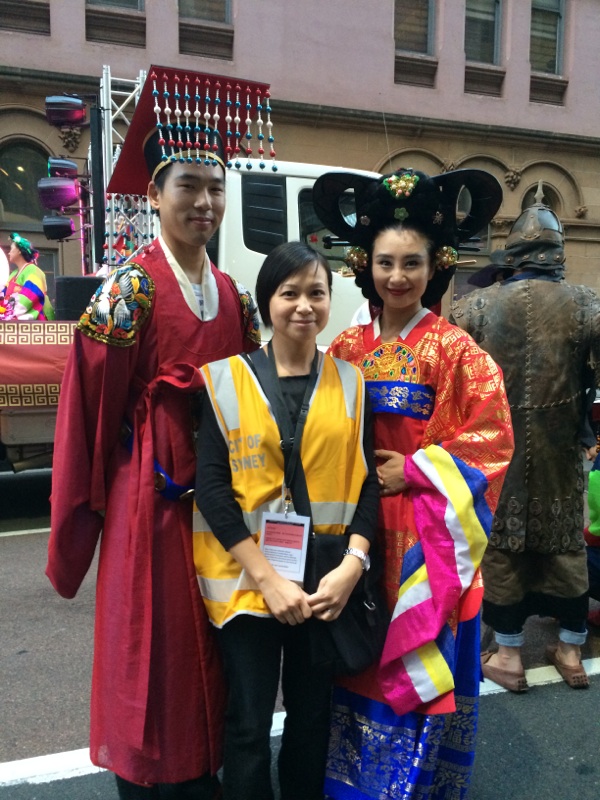More than a Chinese New Year Festival
By Dr Alexandra Wong
12 February, 2015
 Having grown up in Hong Kong, celebrating Chinese new year was always very important to me when I was a child—the new clothes, the red packets, the new year couplets on the wall and the memories of the whole family cleaning our home, preparing the festival food and visiting the flower market are still very vivid.
Having grown up in Hong Kong, celebrating Chinese new year was always very important to me when I was a child—the new clothes, the red packets, the new year couplets on the wall and the memories of the whole family cleaning our home, preparing the festival food and visiting the flower market are still very vivid.
Chinese New Year means even more to me than just the usual cultural festival since I migrated to Australia a few years ago. Not only because I am a Chinese migrant living in Sydney, but also because I am now involved in the ARC Linkage Project 'Sydney's Chinatown in the Asian century: from ethnic enclave to global hub', and one of our research strands is about the Chinese New Year Festival in Sydney.
In greater Sydney about 6.5% of the total population have Chinese ancestry. Sydney's Chinese New Year Festival is now one of the biggest of its kind outside China, and attracts hundreds of thousands local and international visitors each year.
Sydney's Chinese New Year Festival has very humble beginnings. It was started by the local Chinese community based in Chinatown in 1996. With limited resources, but with great community spirit, they put together a Chinese New Year market on Dixon Street and a small parade, probably watched by an audience of a hundred.
19 years later, the Sydney Chinese New Year Festival is much bigger and much more popular. This year there will be over 80 associated events, including different kinds of performances, exhibitions, street festivals and tours, to be held as part of the festival which lasts over three weeks. No longer simply a local community event, the festival is now organised by a professional event management team from the City of Sydney in which hundreds of local and international organisations and corporations participate.
The Twilight Parade is one of the highlights of the festival, in which I took part as a volunteer English-Chinese interpreter last year. The parade started at 8pm, travelled through George Street, Sussex Street, Hay Street and ended with a firework display at 10pm at Darling Harbour. It was made up of 56 colourful, illuminated floats inspired by the zodiac symbol of the animal of that year. Marching with the floats were over 3000 performers, including dance troupes and dragon and lion dance groups, many of them dressed up in traditional costumes, as well as marching bands, hip-hop dancers and pop bands and singers. Over 100,000 people, locals and international visitors, Asians and Westerners alike, lined both sides of the road enthusiastically watching the parade and celebrating the festival.
Nowadays, festivals are usually being used as a strategy for urban re-generation, city branding, attracting tourists and as engines for social cohesion. This is also the case with the Sydney Chinese New Year Festival, which has contributed to the construction of Sydney's identity as a 'multicultural global city'. For example, during the Twilight Parade, symbols and motifs of Chinese traditions and Asian culture are being juxtaposed with western style theatrical displays. In addition to the Chinese performers, many Asian ethnic groups who celebrate the lunar new year, such as Korean, Vietnamese and Thai, also participate in the parade. In this sense, the parade has become a platform to demonstrate the success of multiculturalism in Sydney.
The Sydney Chinese New Year Festival also facilitated the development of cultural diplomacy between Australia and China. With the support from the government of the People's Republic of China since 2005, hundreds of delegations from different provinces have been sent over to Sydney to take part in the festival. Besides, business forums were held between the business delegation from China and members of the local business communities in Sydney. The festival thus helps strengthen the economic and cultural links between the two countries.
For myself, the festival is an important event for developing a 'sense of home' in Sydney. Ritual performance and cultural ceremony are crucial for collective memory, just as Sydney's Chinese New Year Festival has reminded me of my childhood experience of celebrating the same festival in Hong Kong. I am grateful for the fact that I can continue the cultural practice of celebrating Chinese New Year in my new homeland. It is a precious time for me to reflect on and celebrate my Chinese heritage and also an opportunity for the younger generation of Chinese-Australians, like my three year old son, to learn about Chinese culture.
Image above: Dr Alexandra Wong with two parade performers in traditional Korean costumes, taken during the 2014 Chinese New Year Twilight Parade.
Professor Ien Ang discusses the ARC Linkage Project and its research in the Sydney Morning Herald's article: 'The changing face of Sydney's Chinatown' (opens in a new window).